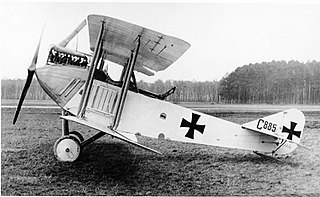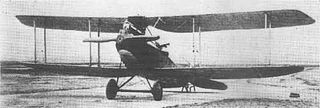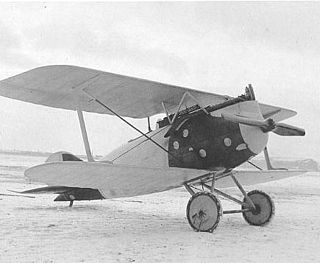Related Research Articles
The AEG C.I was a two-seat biplane reconnaissance aircraft produced in small numbers from March 1915 by the German company Allgemeine Elektrizitäts-Gesellschaft (AEG). It was essentially an AEG B.II armed with a single 7.92 mm (.312 in) Parabellum or Bergmann (rarely) machine gun mounted at the rear of the cockpit for the observer and a more powerful engine. The Benz engine increased maximum speed to a more respectable 130 km/h (81 mph). By October 1915, it had begun to be replaced by the AEG C.II.

The AEG C.II was a German two-seat biplane reconnaissance aircraft produced in small numbers from October 1915. It was a slightly smaller version of the C.I with better performance, redesigned cockpit for both pilot and observer/bombardier, new rear mounting for a 7.92 mm (.312 in) Parabellum MG14 machine gun, and the ability to carry four 10 kg (22 lb) bombs for light attack duties.
The AEG DJ.I was a highly streamlined biplane ground attack aircraft of late World War I that was undergoing evaluation at the time of the Armistice.
Numbers 404 and 405 were the sole two examples of a unique seaplane design produced for the flying service of the Imperial German Navy during the First World War. By 1917, the output of the major German seaplane manufacturers was taken up producing machines for front-line service. As a consequence, the only machines available for training purposes were those that had been made obsolete or which had been damaged and rebuilt. In order to provide modern trainers for the Navy, the Kaiserliche Werft Danzig undertook the design and construction of two brand-new seaplanes between March and June, unarmed two-seat biplanes. These machines were supplied to the naval base at Putzig along with a batch of four trainers of a different design, numbered 467–470.
Numbers 467 to 470 were four examples of a unique seaplane design produced for the flying service of the Imperial German Navy during the First World War. These four aircraft were the subject of an order by the Navy for trainer seaplanes for the base at Putzig, at a time when most trainers were merely obsolete front-line types.
Imperial German Navy seaplanes numbers 1105 to 1106 were the only two examples of a unique design produced for the navy's flying service during the First World War. They were unarmed biplanes of conventional configuration with staggered wings of unequal span. The empennage included a sizable ventral fin. Intended as training aircraft, the pilot and instructor sat in tandem, open cockpits. The undercarriage consisted of twin pontoons. The interplane strut arrangement was remarkable for its day, consisting of N-struts and V-struts without any rigging wires.
Number 1650 was the sole example of a unique seaplane design produced for the flying service of the Imperial German Navy during the First World War. From 1916 onwards, the Kaiserliche Werften produced a range of training seaplanes for the Navy, in order to free the nation's major seaplane manufacturers to produce front-line types. During the closing stages of the war, however, the Kaiserliche Werft Danzig and Kaiserliche Werft Wilhelmshaven produced a small number of front-line types as well, including this machine. Number 1650 was an armed reconnaissance seaplane equipped with radio equipment capable of transmission and reception, therefore gaining the naval CHFT classification.

Imperial German Navy seaplanes 463 to 466 were a unique seaplane design produced for the Navy's flying service during the First World War. The seaplane base at Kiel-Holtenau ordered the type as a training aircraft in 1915, and the Navy allocated a batch of four serial numbers to the design. No 463 and its siblings were conventional, two-bay biplanes with unstaggered wings of equal span and two open cockpits in tandem for the pilot and instructor. The undercarriage consisted of twin pontoons. The large, square rudder was hinged to the rear end of the fuselage, and extended below the ventral line of the fuselage. The inline engine was neatly cowled in, with the exhaust being collected together in a single stack that extended above the upper wing.

Imperian German Navy seaplanes numbers 401 to 403 were the only three examples of a unique seaplane design produced for the Navy's flying service during the First World War. Production of these types commenced in April 1915 in an effort to supply the navy with a seaplane trainer of contemporary design. With the outbreak of war, the output of Germany's major seaplane manufacturers was taken up with producing front-line types, and the only trainers available were obsolete or rebuilt machines withdrawn from their original duties. Number 401 and its two siblings were delivered to the Navy in August 1915.

Imperial German Navy seaplanes 461 and 462 were the only two examples of a seaplane design produced for the Navy's flying service during the First World War. Number 461 was built in October 1916 and Number 462 in September 1917 as the German seaplane bases searched for purpose-built training aircraft to supplement their collection of retired combat types.
Imperial German Navy seaplane Number 945 was the sole example of a unique seaplane design produced during the First World War. Throughout the war, the Kaiserliche Werft Wilhelmshaven had been producing small numbers of training seaplanes for the German Navy, but as the conflict continued, they built a small number of armed types as well, including Number 945. While the general layout of this aircraft was conventional enough for its day, it included a number of unusual features. The single-bay wings were braced with single, large I-struts, and the vertical stabiliser was virtually non-existent, consisting of little more than a stub on the dorsal side of the rear fuselage. The rudder was hinged to the end of the fuselage and hung down below it. The Navy classified it as a C3MG type; indicating armament with both fixed and trainable machine guns.

The Rumpler B.I was a military reconnaissance aircraft produced in Germany during World War I.

The Rumpler C.VII was a military reconnaissance aircraft built in Germany during World War I. It was developed from the C.IV and optimised for high-altitude missions that would allow it to operate at heights that would render it immune to interception by enemy fighters. Work on the C.VII took place after a similar attempt to develop the C.III into a high-altitude machine as the C.V failed.

The Rumpler D.I was a fighter-reconnaissance aircraft produced in Germany at the end of World War I. It was a conventional single-bay biplane with wings of unequal span braced by I-struts. It featured an open cockpit and a fixed, tailskid undercarriage. The upper wing was fitted with aerodynamically balanced ailerons and fuselage had an oval cross-section.

The Rumpler G.I was a bomber aircraft produced in Germany during World War I, together with refined versions known as the G.II and G.III.
The Sablatnig SF-1 was a reconnaissance seaplane built in Germany during the First World War.
The Sablatnig SF-2 was a reconnaissance seaplane produced in Germany during the First World War.
The Sablatnig SF-5 was a reconnaissance seaplane produced in Germany during the First World War.

The Sablatnig SF-8 was a training seaplane produced in Germany during the First World War. While Sablatnig's previous designs for the Imperial German Navy had often seen service as trainers, the SF-8 was purpose-built for this role, at Dr Sablatnig's suggestion. The SF-8 was similar to the firm's earlier designs: a conventional two-bay biplane with staggered wings of unequal span, with open cockpits in tandem.
The Halberstadt B-types of the Halberstädter Flugzeugwerke were two-seat unarmed reconnaissance/training aircraft of the German Air Force in the First World War.
References
- Gray, Peter; Owen Thetford (1962). German Aircraft of the First World War . London: Putnam.
- Herris, Jack (2015). German Seaplanes of WWI: Sablatnig, Kaiserliche Werften, Lübeck-Travemünde, LTG, & Oertz: A Centennial Perspective on Great War Seaplanes. Great War Aviation Centennial Series. Vol. 15. n.p.: Aeronaut Books. ISBN 978-1-935881-27-8.
- Kroschel, Günter; Helmut Stützer (1994). Die Deutschen Militärflugzeuge 1910–1918. Herford: Verlag E.S. Mittler & Sohn.
- Nowarra, Heinz J. (1966). Marine Aircraft of the 1914–1918 War. Letchworth, Harts: Harleyford Publications.